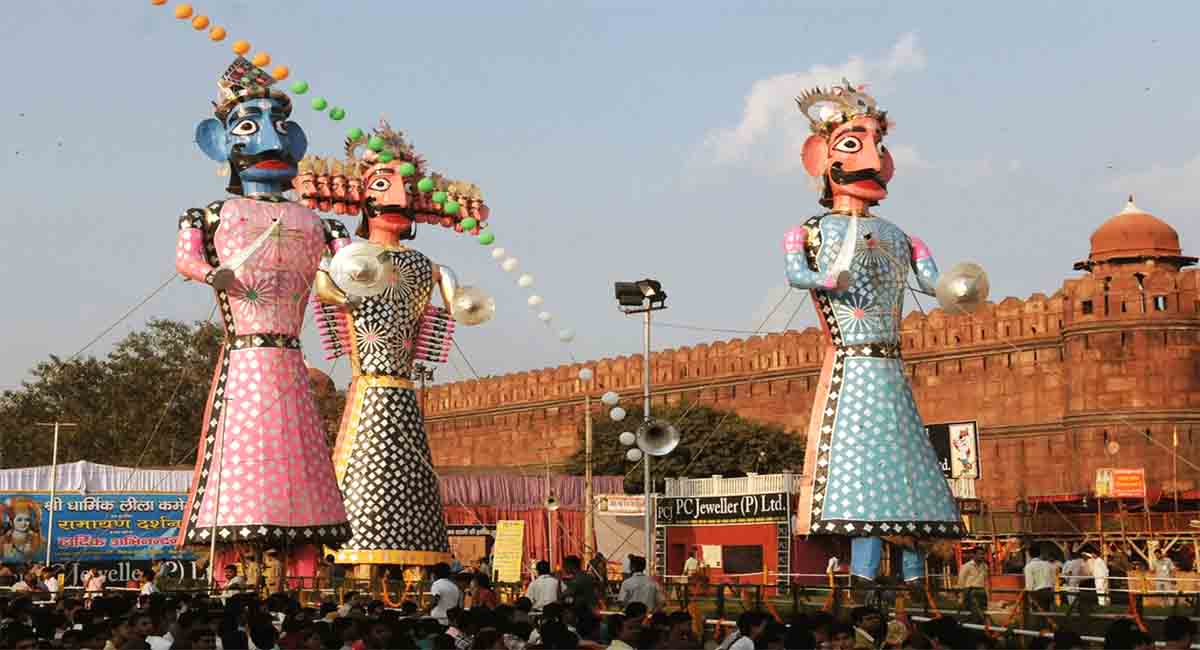Dussehra is a Hindu holiday that celebrates the victory of the avatar of Vishnu, Rama, over the demon king Ravana, who had abducted Rama’s wife, Sita. The festival’s name comes from the Sanskrit words “Dasha” meaning ten and “Hara” meaning defeat, signifying the defeat of Ravana’s ten heads.
It is observed on the 10th day of the Hindu month of Ashvina, which falls in September or October and coincides with the full moon.
Dussehra 2024 Date & Vijaya Mahurat
Vijayadashami on Saturday, October 12, 2024
Vijay Muhurat – 02:03 PM to 02:49 PM
Duration – 00 Hours 46 Mins
Bengal Vijayadashami on Sunday, October 13, 2024
Aparahna Puja Time – 01:17 PM to 03:35 PM
Duration – 02 Hours 19 Mins
Dashami Tithi Begins – 10:58 AM on Oct 12, 2024
Dashami Tithi Ends – 09:08 AM on Oct 13, 2024
Shravana Nakshatra Begins – 05:25 AM on Oct 12, 2024
Shravana Nakshatra Ends – 04:27 AM on Oct 13, 2024
History and Significance of Dussehra
Dussehra is celebrated to commemorate the victory of Lord Rama over the demon king Ravana, as described in the Hindu epic Ramayana. According to the legend, Ravana had abducted Sita, the wife of Lord Rama, and taken her to his kingdom in Lanka. Lord Rama, along with his brother Lakshmana and the monkey god Hanuman, went on a mission to rescue Sita and defeated Ravana in a fierce battle that lasted ten days. The tenth day, when Ravana was finally defeated, is celebrated as Dussehra.
In some parts of India, Dussehra is also celebrated to mark the victory of Goddess Durga over the demon Mahishasura. According to the legend, Mahishasura had received a boon from Lord Brahma that made him invincible. He then went on a rampage and began to terrorize the gods and goddesses. To defeat him, the gods created Goddess Durga, who fought a fierce battle with Mahishasura and finally defeated him on the tenth day of the Hindu lunar month of Ashvin.
Rituals and Traditions of Dussehra
Dussehra is celebrated with various rituals and traditions across India. Some of the most popular ones include:
Ram Lila
Ram Lila is a dramatic re-enactment of the life of Lord Rama, culminating in the battle between Rama and Ravana. The play is performed in many parts of India during the nine days of Navratri leading up to Dussehra and concludes on the tenth day with the burning of effigies of Ravana, his brother Kumbhakarna, and his son Meghanad.
Durga Puja
Durga Puja is a major festival in West Bengal and other parts of eastern India, where it is celebrated with great fervor and enthusiasm. The festival celebrates the victory of Goddess Durga over Mahishasura and the triumph of good over evil. Elaborate pandals (temporary structures) are erected to house the statues of the goddess and her four children, and people visit these pandals to offer prayers and seek the blessings of the goddess.
Ayudha Puja and Saraswati Puja
Ayudha Puja is a ritual where weapons and tools are worshipped, while Saraswati Puja is a ritual where the goddess of knowledge and wisdom is worshipped. Both these rituals are associated with Dussehra and are particularly popular in South India. On Ayudha Puja, vehicles, machines, and other tools are cleaned, decorated, and worshipped to seek their blessings for prosperity and success. On Saraswati Puja, books and musical instruments are placed at the feet of the goddess to seek her blessings for academic success and wisdom.
Navratri Fasting
During Navratri, many people observe fasts and abstain from consuming meat, alcohol, and other indulgences. On the eighth and ninth days of Navratri, people fast and offer prayers to Goddess Durga. On the tenth day, after the victory of good over evil is celebrated, people break their fasts by consuming delicious sweets and traditional dishes.
Decorations and Rangoli
Dussehra is also an occasion for decorating homes and creating colorful rangolis (traditional patterns made on the floor using colored powders). People decorate their homes with flowers, lights, and diyas (oil lamps), and create beautiful rangolis to welcome the goddesses and seek their blessings.
Dussehra Celebrations Across India
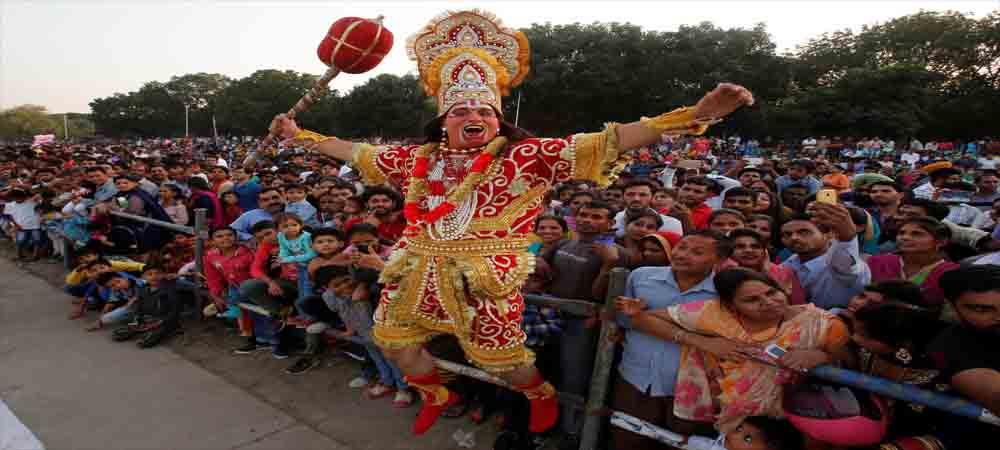
Dussehra is celebrated in different ways across India, with each region having its unique traditions and rituals. Here are some of the most prominent celebrations of Dussehra in different parts of India:
Mysore Dussehra
Mysore Dussehra is one of the most famous and grand celebrations of Dussehra in India. The ten-day festival is celebrated with great pomp and shows in Mysore, a city in the southern state of Karnataka. The highlight of the festival is the grand procession that takes place on the tenth day, which features a decorated elephant carrying a statue of the goddess Chamundeshwari, as well as other cultural and religious displays.
Kullu Dussehra
Kullu Dussehra is a week-long festival celebrated in the town of Kullu in the northern state of Himachal Pradesh. The festival is known for its grand processions, cultural performances, and the burning of effigies of Ravana, Kumbhakarna, and Meghnad. The festival attracts a large number of tourists from all over India and abroad.
Bathukamma
Bathukamma is a festival celebrated in the southern state of Telangana, also known as the “festival of flowers”. Women dress up in traditional attire and create floral arrangements called “Bathukammas”, which are then offered to the goddess Bathukamma. The festival is celebrated for nine days, culminating in the immersion of the bathukammas in water bodies.
Durga Puja
Durga Puja is the biggest festival in West Bengal and is celebrated with great enthusiasm and fervor. Elaborate pandals are erected to house the statues of Goddess Durga and her children, and people visit these pandals to offer prayers and seek blessings. The festival is also known for its cultural performances, such as traditional dances, music, and drama.
Navratri in Gujarat
Navratri is celebrated with great enthusiasm in the western state of Gujarat, and is known for its traditional dance form called “Garba”. People dress up in colorful traditional attire and dance in circles, accompanied by live music and singing. The festival is celebrated for nine days, with the last day being Dussehra, when effigies of Ravana are burnt to celebrate the victory of good over evil.
Dussehra Puja Vidhi
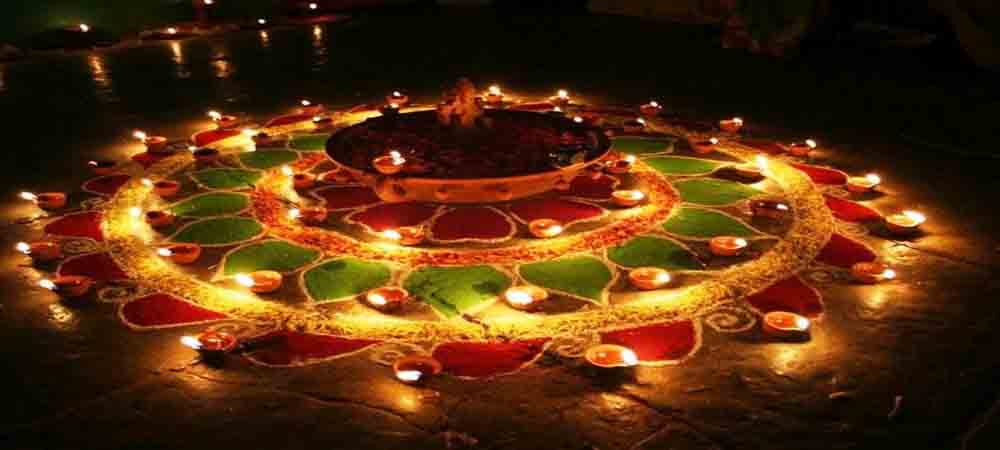
Dussehra Puja is an important part of the Dussehra festival celebrations. It is performed to seek the blessings of the deities and to offer gratitude for their grace and protection.
- Clean the Puja area: Begin by cleaning the Puja area and decorating it with flowers and other auspicious items.
- Install the idols: Install the idols of Lord Rama, Sita, Lakshmana, and Hanuman on a platform or altar. You can also place a picture or statue of Goddess Durga on the altar.
- Light the lamps: Light the lamps and offer incense sticks to create a divine and holy atmosphere.
- Offer flowers: Offer fresh flowers to the deities and chant their names and mantras.
- Perform Aarti: Perform Aarti by lighting the camphor and waving it in front of the deities.
- Offer Prasad: Offer Prasad to the deities and distribute it among the devotees.
- Seek blessings: Seek the blessings of the deities by offering your prayers and expressing your gratitude.
The Dussehra Puja Vidhi may vary from region to region and from family to family. However, the basic steps remain the same, which is to perform the Puja with devotion, faith, and purity of heart.
Astrological Significance of the Dussehra Festival
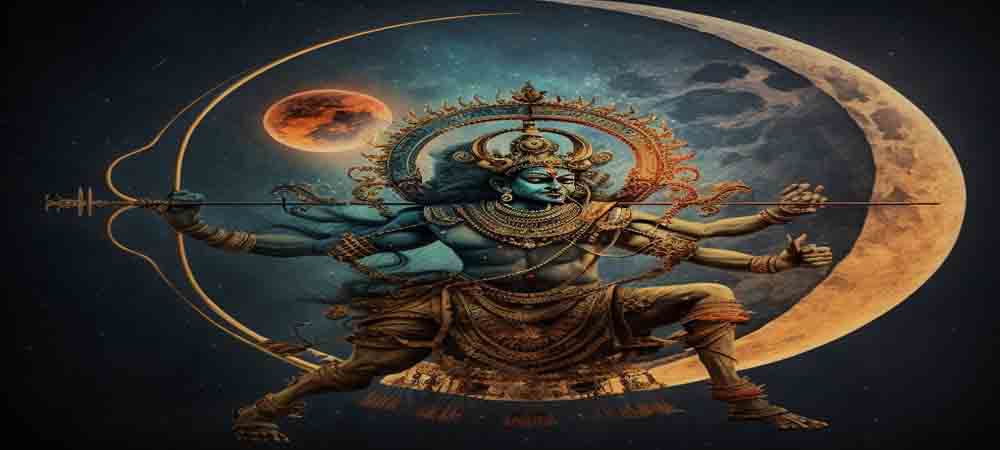
According to Vedic astrology, Dussehra has significant astrological significance. It is believed that the festival marks the transition of the Sun into the zodiac sign of Libra, also known as Tula Rashi. This transition is known as the “Vishuba Sankranti” and is considered to be an auspicious time for performing spiritual and religious activities.
It is believed that during this time, the Sun is in a position of balance and harmony, and the energies of the universe are in a state of equilibrium. This is considered to be an ideal time for seeking blessings and performing rituals for prosperity, happiness, and good health.
Furthermore, Dussehra is also associated with the planet Mars, which is considered to be the planet of strength and courage. The festival is believed to be a time for invoking the blessings of Lord Rama, who is known for his strength, courage, and righteousness. It is believed that by worshiping Lord Rama during Dussehra, one can receive the blessings of Mars and gain strength and courage to overcome obstacles and achieve success in life.
Overall, Dussehra is considered to be a highly auspicious and powerful festival in Vedic astrology and is celebrated with great enthusiasm and devotion by millions of Hindus around the world.
Legend Associated with Dussehra
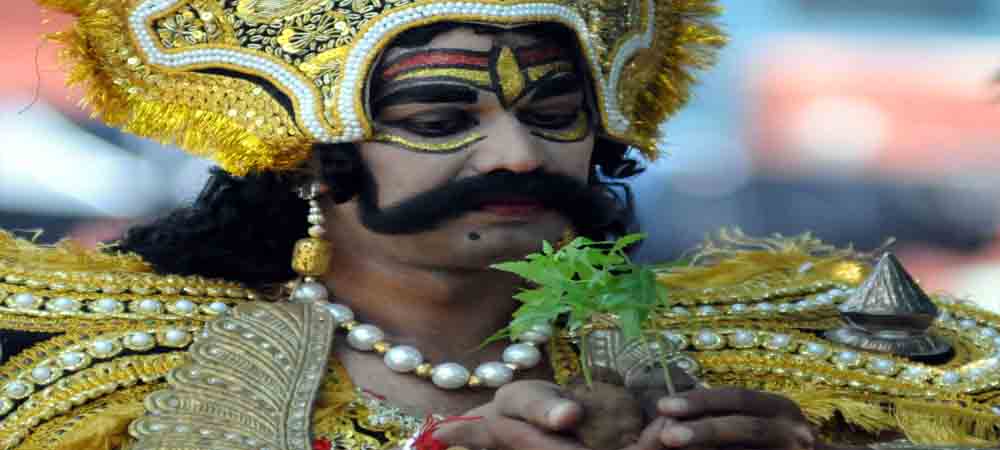
Dussehra is a festival that celebrates the victory of good over evil. The festival has several legends associated with it, but the most popular one is the story of Lord Rama and his battle with Ravana, the demon king of Lanka.
According to the legend, Ravana kidnapped Sita, the wife of Lord Rama, and took her to his kingdom in Lanka. Lord Rama, along with his brother Lakshmana and the monkey god Hanuman, embarked on a mission to rescue Sita and defeat Ravana.
After a fierce battle, Lord Rama killed Ravana and rescued Sita. The day on which Lord Rama killed Ravana is celebrated as Dussehra, which marks the victory of good over evil.
The festival is also associated with the story of Goddess Durga and her battle with the demon Mahishasura. According to the legend, Mahishasura had obtained a boon from Lord Brahma that made him invincible to all male gods. To defeat him, the female gods combined their powers and created Goddess Durga, who battled and killed Mahishasura. The nine-day celebration of Navratri culminates in the victory of Goddess Durga over evil on Dussehra.
The legend associated with Dussehra is a reminder of the triumph of good over evil and serves as an inspiration for people to always strive for righteousness and uphold moral values in their lives.
Dussehra Symbols
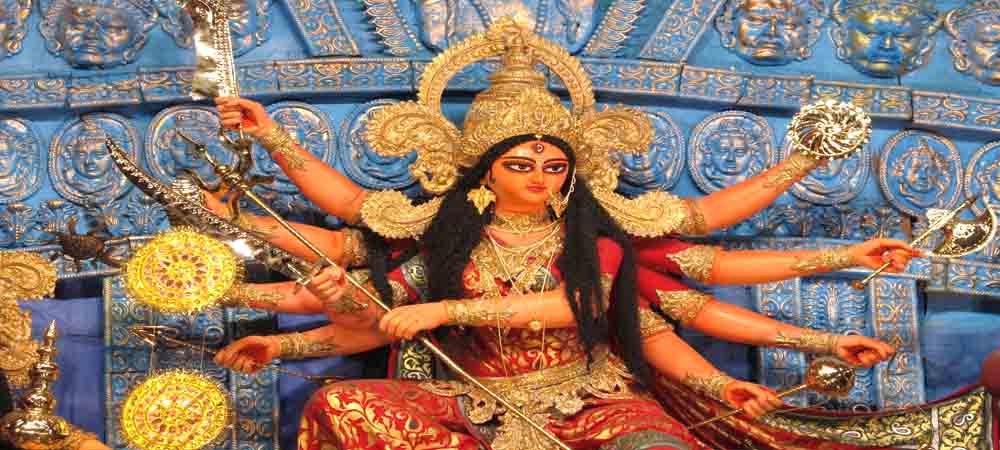
Dussehra is a festival that is rich in symbolism, with several elements that are associated with the celebration of the victory of good over evil.
- Ravana Effigies: One of the most prominent symbols of Dussehra is the effigy of Ravana, which is burnt on the day of the festival to symbolize the triumph of good over evil.
- Bow and Arrow: The bow and arrow are often depicted in images of Lord Rama, who is considered to be the epitome of virtue and righteousness.
- Maa Durga’s Idol: During the nine-day celebration of Navratri, the idol of Goddess Durga is worshipped, and on Dussehra, the idol is immersed in water to symbolize the victory of good over evil.
- Marigold Flowers: Marigold flowers are used extensively during the festival, and are believed to be auspicious and symbolize prosperity and good luck.
- Sweets and Snacks: Sweets and snacks are an important part of the festival, and are shared with friends and family to spread joy and happiness.
The symbols of Dussehra serve as a reminder of the triumph of good over evil and are an important part of the cultural and spiritual significance of the festival.
Dussehra 2024 Red Fort Delhi
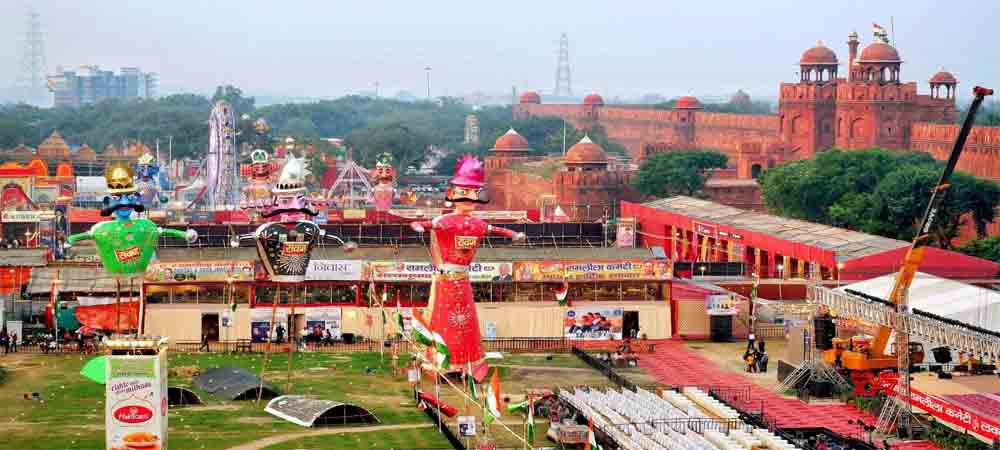
One of the most famous and iconic celebrations of Dussehra in India takes place at the historic Red Fort in Delhi. The event is attended by thousands of people each year and is known for its grandeur and spectacle.
The celebrations at Red Fort are organized by the Shri Dharmic Leela Committee and feature a large-scale reenactment of the story of Lord Rama and his battle against Ravana. The reenactment is accompanied by music, dance, and other cultural performances, and is a major highlight of the event.
In addition to the reenactment, the event also features a large fair, with stalls selling traditional handicrafts, food, and other goods. Visitors can also enjoy rides and games, and watch cultural programs and other performances.
The highlight of the event is the burning of the effigies of Ravana, Meghnath, and Kumbhkarna, which takes place at the end of the day. The effigies are set on fire, symbolizing the victory of good over evil, and are accompanied by a spectacular fireworks display.
The Dussehra celebrations at Red Fort are an important part of the cultural heritage of Delhi and are a major tourist attraction for visitors from across India and around the world. The event is a celebration of the rich traditions and cultural heritage of India and is a testament to the enduring appeal of the story of Lord Rama and his triumph over evil.
Dussehra Facts
Dussehra, also known as Vijayadashmi, is a major festival in India celebrated on the tenth day of the Hindu calendar month of Ashvin, which usually falls in September or October. This day marks the end of the nine-day fasting period of Navratri and coincides with the immersion of the idol of Goddess Durga. The festival celebrates the victory of good over evil, symbolized by the killing of Ravana by Lord Rama and the killing of the demon Mahishasur by Goddess Durga.
According to mythology, the celebration of Dussehra started in the 17th century, when the king of Mysore ordered the festival to be celebrated on a grand scale. Since then, the festival has been celebrated with great enthusiasm and energy. Different parts of India have their own stories and customs associated with the festival.
The most famous Dussehra celebrations take place in Mysore, where the idol of Goddess Chamundeshwari is worshipped and a grand procession is taken out across the city. Other popular Dussehra celebrations in India include those in Kullu, Kolkata, and Orissa, where the festival is preceded by week-long celebrations. People visit Pooja Pandals wearing new clothes, preparing traditional food at home, and celebrating the festival with their friends and families.
In most parts of India, plays depicting the story of Ramayana are organized, which culminate in the killing of Ravana on this day. Statues of Ravana are burnt everywhere in India on Dussehra, and in Delhi, the event is attended by political dignitaries in the Ramlila Maidan. Overall, Dussehra is a festival that spreads the message of victory of good over evil and is celebrated with great fervor and enthusiasm across India and Bangladesh.
Dussehra Mela 2024
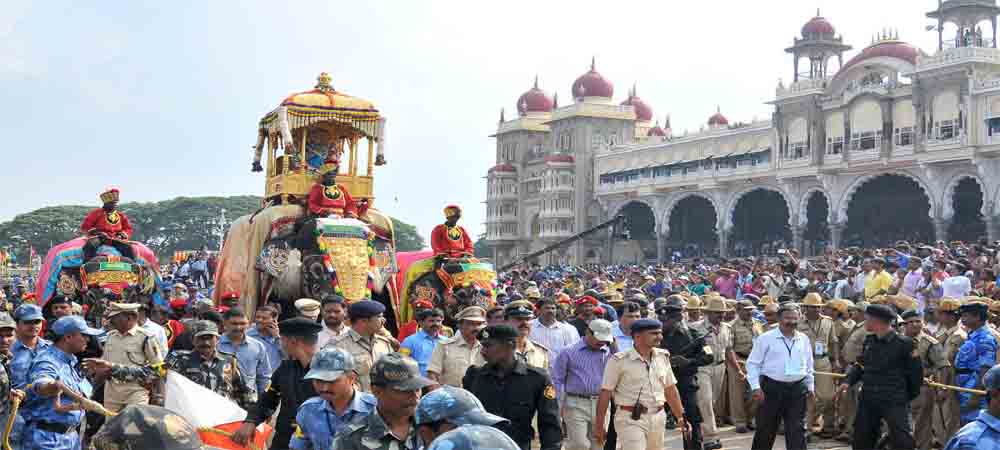
Dussehra Mela, also known as the Dussehra fair, is a popular celebration in India that takes place during the festival of Dussehra. These fairs are usually held in the vicinity of temples or other significant places in various parts of the country.
The Dussehra Mela is a vibrant event that lasts for several days and attracts large crowds of people from all over the region. The fair typically features various activities such as amusement rides, food stalls, handicrafts exhibitions, and cultural performances.
In addition to the fun-filled activities, the Dussehra Mela also has a spiritual significance. The fair is held to commemorate the victory of good over evil, symbolized by the defeat of demon king Ravana by Lord Rama. It is also a time when people come together to offer prayers and seek blessings from the deities.
Some of the most famous Melas in India include the ones held in Mysore, Varanasi, and Kota. These fairs are known for their grandeur and attract thousands of visitors every year.
The Dussehra Mela is a significant celebration in India that combines fun, spirituality, and cultural activities. It is a time when people come together to celebrate the triumph of good over evil and to seek blessings from the divine.
Frequently Asked Questions (FAQs) about Dussehra
Q: What is the real date of Dussehra in 2024?
A: In 2024, Dussehra will be celebrated on October 12th.
Q: What pooja is done on Dussehra?
A: On Dussehra, a special pooja called “Aparajita Pooja” is performed. This pooja is dedicated to Goddess Aparajita, an aspect of Goddess Durga, symbolizing invincibility and victory over evil. Additionally, effigies of Ravana, Meghnath, and Kumbhkaran are burnt to symbolize the triumph of good over evil.
Q: Which god is worshipped on Vijayadashami?
A: Vijayadashami, also known as Dussehra, primarily involves the worship of Lord Rama, who is celebrated for his victory over the demon king Ravana. In some regions, Goddess Durga is also worshipped, marking the end of Durga Puja.
Q: Can I eat non-veg on Dussehra?
A: The consumption of non-vegetarian food on Dussehra varies based on regional customs and personal beliefs. In many Hindu traditions, it is considered auspicious to eat vegetarian food on this day. However, in some communities, eating non-vegetarian food is acceptable.
Q: What should be avoided on Dussehra?
A: On Dussehra, it is traditionally recommended to avoid activities considered inauspicious or negative. This includes avoiding arguments, conflicts, and any actions that might lead to anger or harm. Additionally, it is often suggested to refrain from consuming alcohol and non-vegetarian food, depending on regional customs.
Q: Can we get married on Dussehra?
A: Yes, Dussehra is considered an auspicious day for starting new ventures and undertakings, including marriages. Many people choose to get married on Dussehra due to its significance as a day of victory and good fortune.

